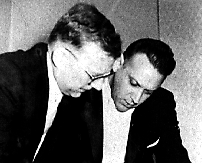 The Interior
The Interior Translated by Antonina W. Bouis
There are two types of symphonic music. In one type, programme music, the content lies "on the surface." In order to convey the content to the audience, the conductor must somehow add the music to a known plot. As a rule, the performer and the audience have less trouble orienting themselves in such music. Music written by the rules of "pure" symphonic composition is another matter. It is felt that such music cannot be "deciphered" verbally, and it elicits individual associations in each listener. Does that mean that in this case the interpreter must refuse to search for a biographical subtext and merely follow the metamorphoses of pure musical forms?I am an adherent of connecting musical images with events from life. Not every work can be "decoded" in detail, of course, but I feel that a conductor can better sense the form and significance of a work if he feels, behind the movements of musical thought, emotions and feelings that can be put into words. Sometimes he even finds a programmed logic that is close to a plot. This also helps him to read more quickly the appropriate emotional state for the concert he is about to conduct.
Naturally, the performer can only speak for himself and cannot pretend to have a literal solution of the composer's intention. But without question, the richer the interpreter's creative intuition, the closer his reading will be to the thoughts and feelings of the composer; similarly, the stronger the interpreter's hypnotic suggestion, the closer the associations of the orchestra and audience will be to his vision - and thereby the emotional effect, born of the spiritual collaboration between performer and audience, will be more powerful.
The work of D. D. Shostakovich is inseparable from the events of his life. That is why, until now, it spoke more to the hearts of audiences in his homeland than outside it. But we may now speak of a renaissance of Shostakovich in the West, since the facts of his life have become known here as well and have forced people to look at his music with new eyes.
I have had the opportunity to conduct all fifteen of Shostakovich's symphonies. Some of them can be called programme music. This includes, first of all, the works that incorporate a chorus or solo singers. In these, Shostakovich's music strives to convey the meaning of the poetry, even though it often conceals poetry that is not very good (or poorly translated) and says much more to the listener than the sung text. Two symphonies, the Eleventh and Twelfth, have titles given by the composer: "The 1905" and "The 1917." (The "Leningrad" subtitle of the Seventh was not the composer's.) Here, the music describes events well-known to the listener - yet even these symphonies are associative as well as illustrative; that is, they throw out a bridge between historical events and the present.
The majority of Shostakovich's symphonies do not have titles and at first glance appear to be plotless. Nevertheless, contemporaries associate each of his symphonies with a specific period in the life of the composer. And this allows the listener to transform the development of musical thought into emotions close to the human heart and into direct plot situations.
I had the good fortune to conduct the première of the Fourth and Thirteenth symphonies, The Execution of Stepan Razin, and the Second Violin Concerto (with David Oistrakh). I met Shostakovich many times and we spoke of music and various problems. He was seven years my senior - an enormous gap when you are young, and inconsequential when you are over fifty. I worked in Leningrad when Shostakovich lived there, and then in Moscow, where the composer moved after the war. The historical cataclysms that gave life to Shostakovich's music passed before my eyes as well, and they were part of my life, too.
Several of his symphonies elicited such vivid associations with our reality that I developed them to full programme detail. Dmitri Dmitryevich knew about my "decodings". He himself did not like to discuss the subtext of his music and usually said nothing, although he did not contradict me either. Since he was usually pleased with my performances, I believe he had no objection to such an approach to his music.
It was with the greatest agitation that I read Shostakovich's memoirs, prepared by Solomon Volkov. Much of what comes as a surprise to the Western reader was not a surprise for me. I knew many things and guessed many others; but there were new things in it even for me, things that made me look at some of his works differently.
This will probably lead to a re-evaluation of some of my interpretive concepts, since there is a definite connection between a performing interpretation of music and what we know about the composer's inner motives and reasons. A striking confirmation of this position is the music of the great symphonic composer of the twentieth century, Dmitri Dmitryevich Shostakovich.
Kyrill Kondrashin
1914 - 1981